Memento Park is an open-air museum that celebrates the demise of Communism by displaying the large statues and monuments that were erected in Budapest during the communist regime between 1947 and 1989.
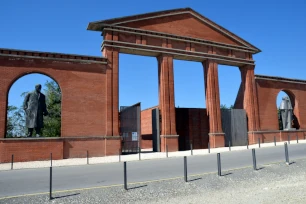
After the Second World War, Hungary came under the Soviet sphere of influence. Stalin’s promise in 1945 at the conference of Yalta to implement democracy in Central and Eastern Europe was never fulfilled, and instead Hungary was transformed into a totalitarian dictatorship under the guise of a “people’s democracy”. After a failed revolt in 1956 the regime was relaxed, but democracy and independence only returned with the Fall of Communism in 1989.
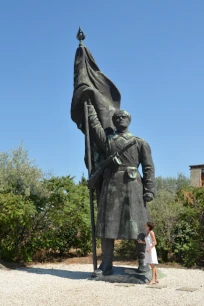

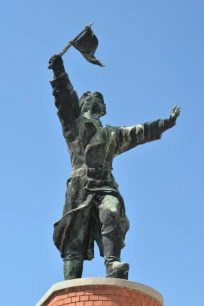
Creation of a Statue Park
Over the years, numerous monuments had been erected in Budapest to the honor and glory of Communism and its leaders. These monuments were quickly removed after the events of 1989. In 1991, shortly after the last Soviet troops had left Hungary, Budapest’s city council decided to move a selection of the monuments to a new park that would serve as a reminder of Hungary’s communist past and as a way to celebrate the fall of Communism. The park was originally called Statue Park (Szoborpark) but is now usually referred to as Memento Park.
Memento Park was designed by architect Ákos Eleőd and opened to the public in 1993. Over the years it expanded in phases and now contains forty-two statues as well as exhibitions about life in Hungary during the Cold War. The park is divided into two parts: the actual statue park, dubbed ‘A Sentence about Tyranny’ and the ‘Witness Square’, bordered by buildings that house a visitors and educational center. The square represents the Eastern and Central European squares where revolts against the Soviet regime broke out.
The Statues
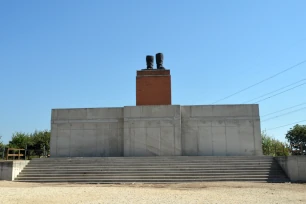
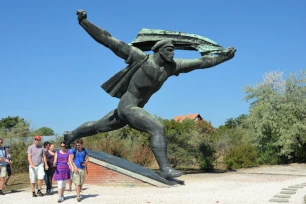


The Communist-era statues are strewn around the park and can be seen up-close. They are surprisingly large and often impressive in their monumentality.
The entrance of the park has a mock facade in neoclassical style. To the left and right, framed by open arches, are statues of Lenin and the authors of The Communist Manifesto, Marx and Engels. Lenin’s bronze statue was created in 1965 and stood at the edge of the city park. The granite statue of Marx and Engels was created in 1971 in a cubist style and ‘graced’ the main entrance of the headquarters of the communist party.
The most important monument of the Communist era in Budapest was an eight meter (26 ft) tall bronze statue of Stalin. The statue stood on a huge 9.3 meter high podium. It was located at Felvonulási tér (Parade Square) near the city park. From the podium, which was decorated with symbolic reliefs, communist party leaders oversaw military parades. Today its place is occupied by the Monument to the Uprising, a monument commemorating the anti-Soviet revolt of 1956. During the revolt the statue was toppled and only the boots remained. Ákos Eleőd recreated Stalin’s podium and boots in Statue Park, where it is known as the Grandstand.
Another interesting monument is the statue of the Liberation Army Soldier. The six-meter tall statue once stood in front of the Liberation monument at the top of Gellért Hill and celebrated the liberation of Budapest by the Soviet army. It was also demolished in 1956 but later replaced with an exact copy.
Other favorites include a monument of two giant hands holding a sphere – an allegorical representation of the Workers’ Movement – and the Soviet-Hungarian Friendship, symbolized by two people shaking hands. One of the largest monuments in the park is the modern and chaotic looking Béla Kun Memorial, created in 1986. It shows the Hungarian communist leader Béla Kun trying (but failing?) to lead a group of soldiers and workers. The most iconic statue is probably the Republic of Councils Monument, created in 1969. Its design was based on a famous revolutionary poster of a charging sailor holding a flag.
More Sights
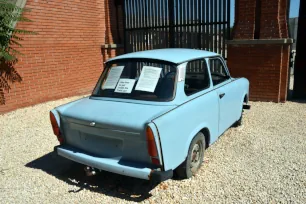
Memento Park also features an exhibition that educates visitors about the communist era during the twentieth century. It highlights the events of 1956, when the statue of Stalin was torn down and the turmoil of 1989-1990, when the whole communist system fell apart. You can also see the “Life of an Agent”, a film montage that shows how the secret police was trained to snoop on its own citizens. You are also invited to step into a Trabant, the so-called “people’s car” that is affectionately known as Trabi.
Getting There
Memento Park is located in the XXIInd district, well outside the city center of Budapest. The easiest and best way to get there is by taking the Memento bus that leaves at least once a day from Deák Ferenc tér. More info can be found on the official website of Memento Park.

